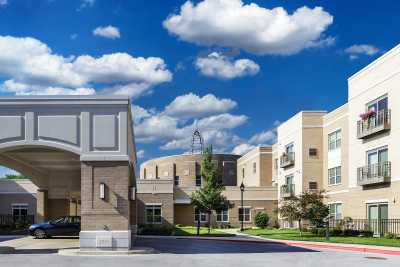Recognizing the Care and Support Supplied by Assisted Living Areas

Levels of Treatment Supplied
Aided living neighborhoods provide differing degrees of treatment tailored to fulfill the unique requirements of each resident, guaranteeing comprehensive support and aid as called for. These areas aim to create a balance in between independence and aid, giving residents with the required help while advertising autonomy. The very first degree of treatment typically entails basic support with tasks of daily living (ADLs), such as dressing, bathing, and medication monitoring. This level appropriates for people who require very little assistance but take advantage of the safety and amenities provided by the area. Senior Assisted Living.
Moving up, some locals might need advanced treatment, consisting of aid with wheelchair, continence administration, or specialized medical services. This intermediate level of care makes certain that homeowners get the certain support they need while maintaining a sense of self-respect and regard. For people with more complicated cognitive impairments or clinical demands, a greater level of care including knowledgeable nursing and 24-hour guidance might be essential. Helped living neighborhoods adjust their services to accommodate these differing levels of care, making sure that residents can age in location easily and securely.

Assistance Provider Available
Enhancing the lifestyle for residents, helped living communities provide a series of assistance solutions customized to satisfy specific needs and preferences. These solutions encompass numerous facets of everyday living, including aid with activities of day-to-day living (ADLs) such as bathing, dressing, grooming, and medication management (Charlotte Alzheimer's care). Additionally, locals can gain from housekeeping and washing solutions, ensuring their living areas are clean and well-kept

In terms of health care assistance, assisted living communities might provide access to on-site nursing staff or sychronisation with outside healthcare carriers. This makes certain that residents obtain correct treatment and assistance with health-related demands. On the whole, the wide range of assistance solutions available in assisted living areas aims to boost residents' total wellness and offer a comfy and fulfilling living setting.
Features Offered
Residents of assisted living areas profit from a large range of features customized to boost their daily living experience and total convenience. These services often include roomy living accommodations, housekeeping and washing solutions, transportation assistance for medical consultations and trips, as well as healthy and scrumptious dishes offered in common dining areas. Numerous assisted living areas additionally offer leisure and social tasks such as fitness classes, crafts and arts sessions, flick nights, and group trips to local destinations.
Additionally, services like on-site appeal salons, libraries, game rooms, and outside gardens provide residents with opportunities for relaxation and socializing. Some neighborhoods have health centers with workout devices and scheduled health and fitness programs to advertise locals' physical wellness. Charlotte Alzheimer's care. Additionally, several assisted living centers use 24-hour security and emergency situation response systems to make sure homeowners' safety and satisfaction
Personalized Care Plans
Individualized treatment plans are thoroughly crafted at assisted living neighborhoods to accommodate the special needs and preferences of each read local. These personalized treatment strategies are established through extensive analyses performed upon admission and consistently reviewed and adjusted as locals' requirements develop. The procedure starts with an extensive analysis of each citizen's physical, psychological, and cognitive health, in addition to their individual preferences and way of life selections.
Once the analysis is full, a team of healthcare professionals teams up with the homeowner and their family members to develop a personalized treatment strategy that attends to certain demands, such as medicine administration, help their explanation with day-to-day activities, specialized dietary demands, and social engagement opportunities. The goal is to provide customized care that advertises independence, dignity, and total wellness.
In addition, these care plans are designed to be adaptable and flexible, ensuring that locals receive the ideal level of assistance in all times. Regular evaluations and communication between team, residents, and households help to make sure that the care plans stay appropriate and reliable in meeting the progressing needs of each citizen. By tailoring treatment strategies to the distinct attributes of each individual, aided living neighborhoods make every effort to improve the lifestyle for all locals.
Citizen Engagement Tasks
To foster a sense of neighborhood and well-being, helped living areas curate a diverse array of appealing activities for citizens. By providing a wide variety of tasks, assisted living neighborhoods aim to develop a dynamic and inclusive setting where citizens can take part in activities that bring them pleasure and fulfillment.
Additionally, resident involvement tasks play a critical role in combating feelings of seclusion and solitude, typical amongst seniors. These activities supply opportunities for citizens to connect with their peers, build significant partnerships, and maintain a feeling of function and belonging. By actively engaging in these tasks, residents can boost their top quality of life and overall health while appreciating a feeling of neighborhood within the assisted living setting.
Final Thought
Finally, aided living neighborhoods provide various levels of treatment, support services, amenities, personalized treatment plans, and resident engagement tasks. These areas provide an alternative approach to looking after individuals that may need help with everyday jobs or need a risk-free and supportive living environment. By understanding the care and support supplied by assisted living communities, individuals can make educated decisions regarding their lasting care alternatives.
From degrees of treatment supplied to the array of facilities and personalized care strategies, each area tailors its offerings to provide to the distinct needs of its homeowners.Individualized care strategies are diligently crafted at assisted living neighborhoods to cater to the special requirements and preferences of each resident. Regular assessments and interaction between team, homeowners, and households aid to make certain that the care plans continue to be effective and relevant in satisfying the advancing needs of over at this website each local.To promote a feeling of community and wellness, helped living areas curate a varied variety of engaging tasks for residents.In conclusion, helped living communities supply different levels of care, support services, facilities, individualized treatment plans, and resident involvement tasks.